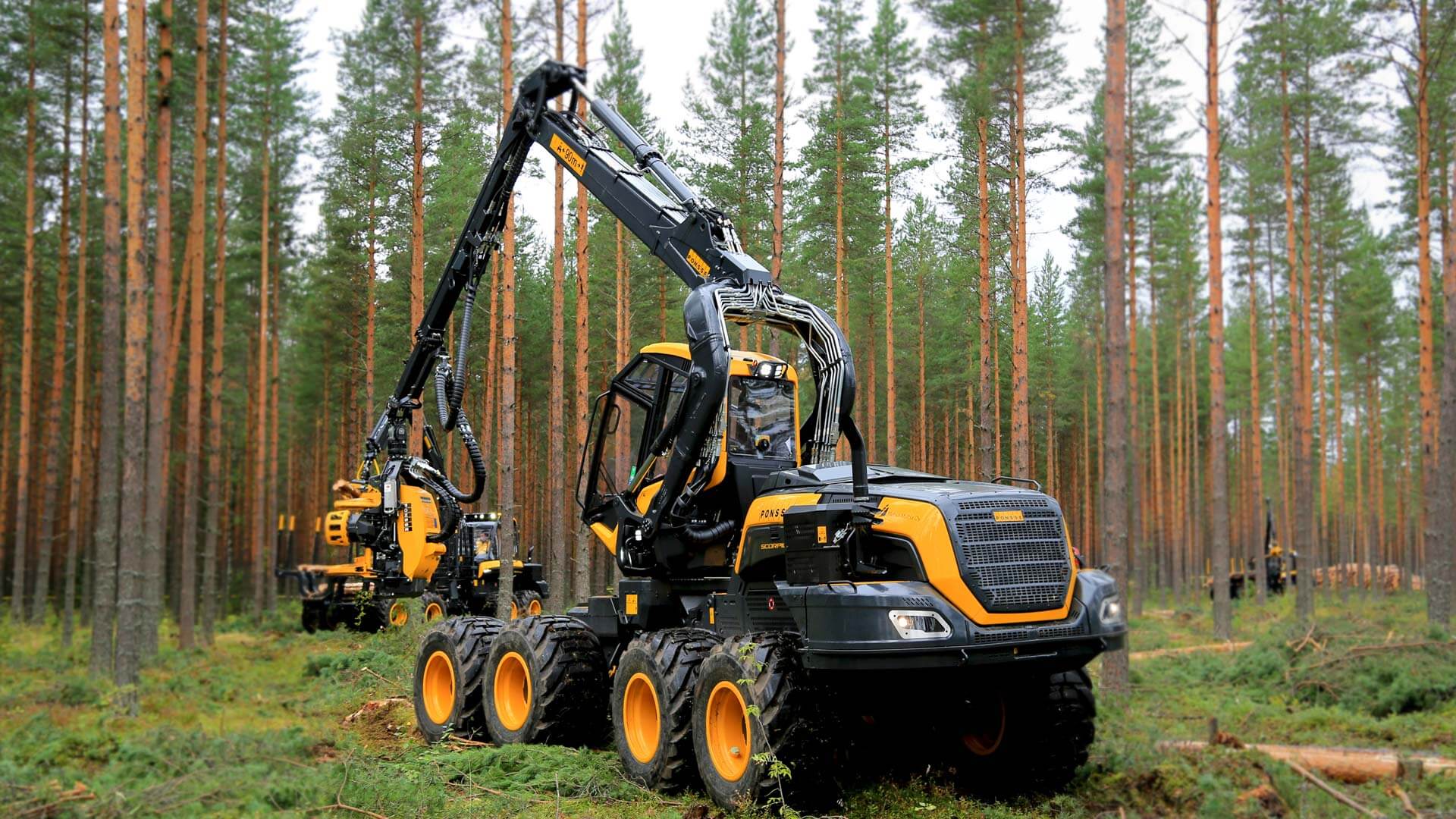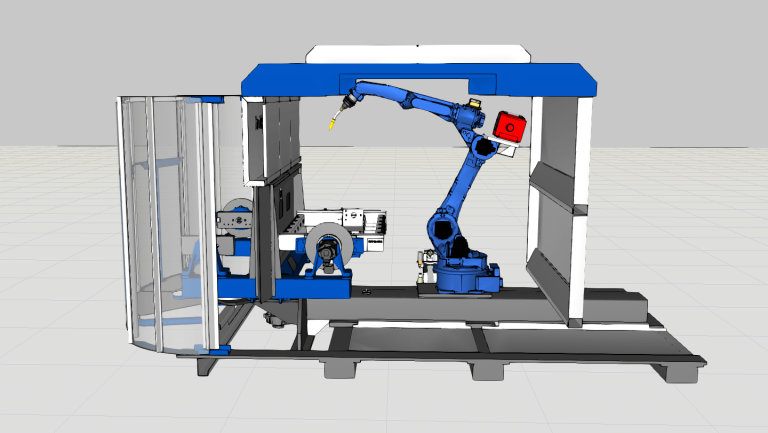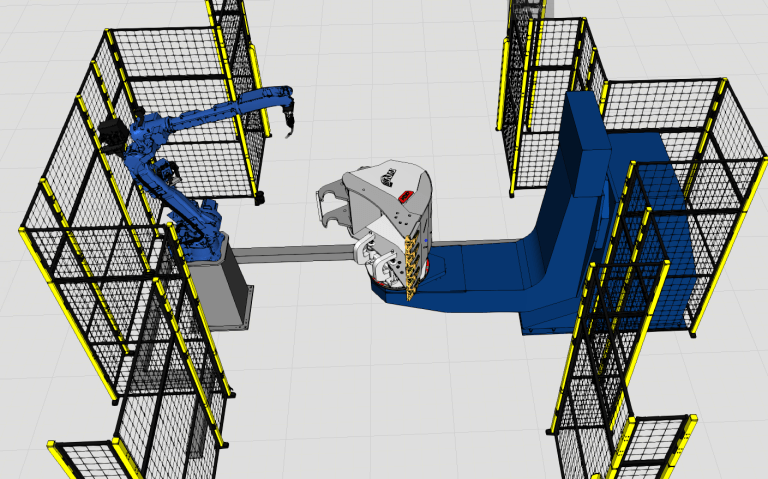Ponsse is driving forest machine innovation and improving productivity with Visual Components Robotics OLP
Ponsse Plc., a global leader in forest machine manufacturing, has transformed its production process by leveraging Visual Components Robotics OLP.

Pioneering customer-oriented forest machine manufacturing
Established in 1970 with a mission to manufacture the world’s best forest machines, Ponsse Plc., a Finnish company, is a global pioneer in the forest machine industry. With a 40,000 sq. m. (430,000 sq. ft.) factory in Vieremä, the company specializes in the sales, service, manufacturing, and technological development of environmentally-friendly cut-to-length forest machines. Ponsse employs over 1,800 people, operates in 40 different countries, and manufactures a wide range of harvesters, forwarders, and other machines.
With innovation as one of its core values, Ponsse is committed to advancing sustainable forestry through continuous improvement of products, services, and processes for customer success. This has resulted in the creation of modern forest machines and a growing number of satisfied customers. To meet customer demand, Ponsse manufactures around 1,000 machines per year and commissions approximately one new robot station annually.

Boosting productivity with robotic welding and offline programming
In challenging production environments, welding automation is essential to increase productivity. Recognizing this, Ponsse has always prioritized the improvement of welding processes in its production development. This understanding led them to implement robotic welding more than 15 years ago. Heikki Selkälä, Production Development Manager at Ponsse, shared that their goal is to robotize all basic welding, as part of their broader initiative to automate as many processes as possible, with a particular emphasis on welding.
When Ponsse incorporated robotic welding into their operations, they encountered difficulties because of the complexity and time-consuming nature of robot programming. The programming was carried out online using a teach pendant, requiring the robot to be inactive for a two-week period until the programming was finalized. This pause in operation had significant cost consequences, as it could potentially cause delays in the manufacturing process.
To address these challenges and significantly reduce robot programming time, Ponsse needed a partner with the expertise and understanding of offline programming. The solution combines the offline programming expertise of Delfoi Robotics, now Visual Components Robotics OLP, with the powerful Visual Components platform.
Today, 80% of the equipment are welded by robots. Our partner for offline programming of these robots has been Visual Components since the beginning. The cornerstone of our common growth story has been the continuous development of Visual Components software to meet our needs. Their process expertise has developed considerably, and we have always been able to rely on their agile way of working.
Heikki Selkälä, Production Development Manager, Ponsse
Ponsse sets high standards for its production processes and expects the same level of customer-centric, long-term commitment, and reliability from its partners. Visual Components Robotics OLP, previously known as Delfoi Robotics, has been fulfilling these requirements for over 15 years.
Enhancing automation utilization for continuous production
With the help of Visual Components Robotics OLP, despite Ponsse’s highly demanding production processes and complexity of the robot programs, the programs can be completed within one day. The programs consist of Yaskawa robots performing the welding of forest machine frames, including several curved welds and welds within frame structures.
The benefits of offline programming are realized everyday. As a key benefit, I see that offline programming makes things much faster and easier when robot programming can be done outside of production system without stopping production. Before, we had to make the necessary adjustments during the weekend before the production continued on Monday. Instead of the ten days that programming previously took, now the programming can be completed in just one day.
Asko Haataja, Head of Robotics Team, Ponsse

Improving weld accessibility to maximize productivity
In addition to offline programming, Ponsse uses the robot programming and simulation software to evaluate weld design for practicality, weldability, and accessibility. By testing weld design in conjunction with product development, the manufacturer ensures that the welding process is efficient and can reach difficult areas. This helps maximize the proportion of robotic welding relative to manual welding.
During online robot teaching, there are scenarios where “hidden spots” in the welded parts are not visible to the operator and therefore require manual welding. However, with offline programming, the operator can view the product in the CAD model, enabling the welding of internal, hidden areas with a robot. This significantly increases the degree of automation and accelerates the entire production lead time by dramatically reducing the need for manual welding.
The customizability and the features of Visual Components Robotics OLP have been excellent for our needs. The visual platform is practical and the code can do things that would otherwise require manual operation. When the need is to weld with multi-axis portals, an ordinary software company could not serve us. Especially in these matters, Visual Components’ flexibility and agility brings us benefits that we value.
Heikki Selkälä, Production Development Manager, Ponsse
Visual Components Robotics OLP is utilized not only when introducing new products but also in refining existing programs, reflecting Ponsse’s commitment to continuous development.
Streamlining robotic station design and calibration of multi-robot brands
When planning for new robot cells, Ponsse uses Visual Components from the robotics concept design to ready-to-go robot programs. The design of new robot layouts is an iterative process, during which Ponsse uses Visual Components as a layout design tool. This tool helps define the optimal layout for a specific robot configuration and the products to be manufactured in the robot cell. The all-in-one Visual Components Robotics OLP, being universal and compatible with all robot brands, supports Ponsse’s use of multiple industrial robots from different manufacturers.
When the design of a new robotic welding station starts, we will model a digital replica of the station with software and test the welding possibilities of the parts. Once the investment decision has been made, I will contact Visual Components and we will continue to complete the planning.
Asko Haataja, Head of Robotics Team, Ponsse
The advanced simulation capabilities of Visual Components Robotics OLP enable accurate validation of robot programs prior to their deployment in production. The final stage of new robotic station implementation, known as commissioning, involves calibration of the designed robot cell for accuracy, ensuring that the programs function accurately for a faster production ramp up. Ponsse has several Yaskawa and ABB robot stations, all of which are programmed offline.
A good example of Visual Components’ agile operations and rapid response is how they developed remote calibration for offline programming during these exceptional circumstances in recent times. In particular, they don’t have to be physically present here at the factory to advise us when the calibration of the robots can be done virtually from anywhere.
Asko Haataja, Head of Robotics Team, Ponsse
Ponsse’s partnership with Visual Components has resulted in significant time savings, improved productivity and automation utilization, streamlined robotic station planning with faster and easier robot programming. This case study exemplifies how Ponsse, a global leader in forest machines, has harnessed innovation and productivity with Visual Components Robotics OLP to stay ahead of the competition in the industry.
About Visual Components
Founded by a team of simulation experts and amassing over 20 years in business, Visual Components is one of the pioneers of the 3D manufacturing simulation industry. The organization is a trusted technology partner to a number of leading brands, offering machine builders, system integrators, and manufacturers a simple, quick, and cost-effective solution to design and simulate production processes and offline robot programming (OLP) technology for fast, accurate, and error-free programming of industrial robots.
Want to learn more about the benefits of our solutions for your business? Contact us today!
Further reading

Maximizing efficiency and ROI from day 1: Duun Industrier pre-programs a welding robot cell with Visual Components OLP
Duun Industrier, a leading Norwegian heavy machinery manufacturer, installed the Nordics’ largest robotic welding station in 2013. Utilizing Visual Components for robot programming since 2014, they commissioned a new robot...

Combatting the welder shortage: how AMI Attachments enhances production efficiency with Visual Components OLP
AMI Attachments, a leading North American manufacturer of heavy equipment attachments, sought to improve product throughput and meet evolving market demands while navigating a welder shortage. By implementing Visual Components...

AFRIT production runs faster than ever, thanks to Visual Components Robotics OLP
Read how a trailer manufacturer from South Africa improved the manufacturing efficiency by using Delfoi Robotics Offline Robot Programming solution (Now known as Visual Components Robotics OLP).